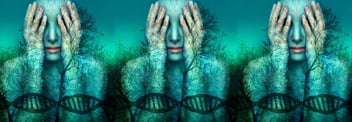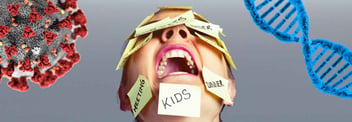How an “Orchid Gene” Fashioned an Existential Crisis in a Recent College Graduate
- Home
- Blog

Reader, nothing is more empowering than the feeling that our lives are finally coming together—we’re working towards something, we’re building something great, we’re growing, connecting, and loving fully and completely. In other words, we’re blossoming. On the flipside, nothing is more disconcerting than the feeling that, suddenly, all of that “togetherness” is falling apart right before our eyes—when this occurs, we feel the great thing we were building was just a lie, that we were deluding ourselves thinking we could have grown or changed, that we’re not just back to square one in terms of our personal evolution—we’re worse off than where we were before. We’re not blossoming—we’re wilting. Oftentimes, this seemingly catastrophic struggle aligns with a crisis tied to the life stage in which we find ourselves: when we are fresh out of college, we feel hopeful about job prospects and devastated when we don’t land the career we longed for. When we are in a serious romantic partnership, we see a bright and promising future and then that future is stripped away when our hearts are broken. As we illustrated last week in “ Charlie’s story,” each era in our lives is defined by emotional challenges we must overcome—and the process of doing so can often throw us into an existential crisis, where suddenly we look at our lives and see nothing but failure.
Existential crises befall many of us. However, some individuals are equipped with a greater emotional resiliency in the face of these crises, while others may feel that existential pain reverberating through their bodies and minds for months if not years. Reader—this isn’t about one group of people somehow being “better” or “smarter” than the other group. This is about the cards we’re dealt at birth, in the form of our personal genetic makeup. However, those cards are just one part of the story—what really matters is how we play them… and boy, can we play them to our advantage if we understand what we’re working with! This week, I want to tell you about a young woman’s journey toward greater emotional resiliency in the face of an existential crisis, and how a simple cheek swab gave her the tools she didn’t even know she needed. For those of you who have read my self-help book, Becoming Whole: A Healing Companion to Ease Emotional Pain and Find Self Love, you may remember the story of Alice from “Session Six – Letting Go of Your Child as They Become an Adult.” If you haven’t read it, I have posted it at the end of this blog, and you may want to read it now to place today’s story about her into context. Now, let’s dive in!
Alice’s Story, Part Two: Building a Life… Until Everything Fell Apart
Alice first came to see me when she was 17. At that time, she held a lot of anger towards her parents which we worked through over the course of 18 months. Following termination from treatment, over the next five years Alice truly blossomed, attending college down south, participating in sorority life, and successfully majoring in digital communications.
Sadly, Alice recently returned to see me in a crisis, fearing her life was coming apart, and that she was doomed to a bleak future. The good news was she had graduated college, secured a really good job where they liked her, and was in a monogamous relationship with a boyfriend who was going places and who treated her with love and respect. The bad news was that two weeks earlier she had been stopped by the police for driving erratically, and when they searched her automobile they discovered an ounce of marijuana and a half dozen opioid tablets. In recounting this story to me, she suddenly burst into tears, and in confused bewilderment commented, “Dr. Kehr, I don’t know what came over me to blow up my life this way! Everything had been going so well, what could possibly have made me behave in such a self-sabotaging way? I have been reading your blogs on genetic testing and wondered if some of my genes had anything to do with this?”
As I listened to her, I considered her hypothesis. How could her genotype predispose her to lawbreaking behavior? As it turned out, this question led me to a novel formulation about the intersection between her personal genotype and her unconscious mind. As Alice was quite depressed, was unable to sleep, was having suicidal thoughts, and could barely concentrate at work, I recommended that I prescribe an antidepressant for her following a simple cheek swab to genetically test her “mental health genes,” thereby prescribing for her in a more personalized and precise fashion. What emerged from the test report, when combined with her “life-stage story” of recently graduating college, began to explain her Self-Saboteur behavior.
Are Your Genes Responsible? How Alice’s Genetic Profile Explained Her Emotional Breakdown
Alice had 1½ “Orchid Genes” that I have been writing about in recent months (I’ll explain my 1 ½ measurement in the following paragraph). To refresh your memory, while orchids are famous for their stunning beauty and diversity, they are infamous for the extremely delicate cultivation required of them. They require strong light, but not direct sunlight. They need high humidity and good air circulation—specifically around their roots. They need time to dry out, but also require heavy watering, mimicking drenching rainfall. And like Goldilocks, they need just the right temperature, between 50 and 85 degrees. Some individuals are like orchids—absolutely incredible, requiring just the right circumstances to truly thrive. But place these orchid individuals in a “harsh” environment and they will wither—unless they get help.
On Alice’s SLC6A4 gene she had one “Short” allele (1/2 an orchid gene) and her COMT was the Met/Met variant (a whole orchid gene). Her SLC6A4 genotype conferred a somewhat increased “serotonergic tone” (too much serotonin) in her brain’s amygdala, where fear responses are processed, and thus she would have a somewhat higher-than-average fear response and greater response to stress, including a greater release of cortisol, with higher rates of anxiety and depression. Her COMT Met/Met variant would exacerbate the effects of her SLC6A4 gene as it is is associated with “dopamine flooding” of the frontal lobes under stress, which results in increased anxiety levels and cognitive perseverating (ruminating over and over again about things)—also resulting in a higher stress response. Together, these two genes would worsen her “fight, flight, or freeze” response and create higher levels of chronic stress.
“Why Now?” How Existential Crises Map to Important Life Stage Events
Alice’s genes provided an important backdrop to understanding her current life crisis, but the question remained: Why sabotage her life now? Why the renewed existential crisis? Alice’s story revealed the clues. While in college, Alice experienced a sense of belonging for the first time in her entire life. In high school, she had been a loner that didn’t belong to any social groups, but in college she’d gained a number of close friends and had become a valued and cherished sorority sister. Further, she lived in a community where she had a clear sense of self. In addition her boyfriend lived in the same apartment building, and they spent almost all of their spare time together.
Following graduation, however, this all changed. She lost her identity as a sorority sister and her closest friends moved back to their home towns. Alice’s boyfriend’s job required frequent out-of-state travel, and the location of his office required him to live about 45 minutes from her. In short, she came to feel lonely, all-alone, and bereft. In response to this emotional pain, she began smoking weed in an attempt to ease it, and on occasion took some Oxy with friends. When the police confiscated these drugs from her car, she had been on her way to a reunion with her college buddies.
Alice’s early-adulthood life stage challenges and recent losses, in combination with her orchid genes and her longstanding unconscious predisposition to sabotage her life when under conditions of chronic stress, all conspired together to create this existential crisis inside her.
Exiting an Existential Crisis: With Treatment, It’s Possible
Our treatment needed to address her life stage challenges, orchid genes, depression, insomnia, suicidal thinking and legal challenges. We once again began weekly talk therapy to give her emotional support and help her figure out the unconscious forces that drove her self-sabotaging behaviors. We put her on an SNRI antidepressant that helped reduce her depression and anxiety, and improve her sleep; N-acetylcysteine and ashwagandha to reduce her exaggerated stress response; and I worked with her attorney to get her into an outpatient substance use disorder clinic while she also engaged in community service. Her court hearing is scheduled for next month, and we are hopeful that with my explanatory letter to the court combined with her intensive outpatient treatments she will be granted clemency.
Read “Session Six – Letting Go of Your Child as They Become an Adult.”
For those of you who have read my self-help book, Becoming Whole: A Healing Companion to Ease Emotional Pain and Find Self Love, you may remember the story of Alice from “Session Six – Letting Go of Your Child as They Become an Adult.” This chapter places today’s story about her into context. Click the button below to read “Session Six.”
Related Information
- Learn about Genetic Testing
- Learn about Potomac Psychiatry
- Meet Our Doctors
- Contact Potomac Psychiatry
.png?width=144&height=144&name=Untitled%20design%20(34).png)



